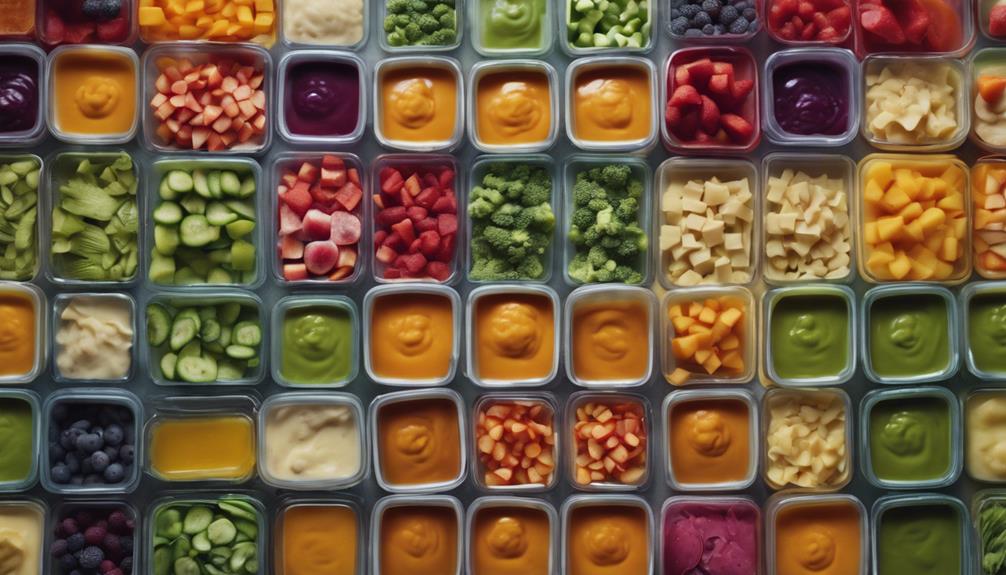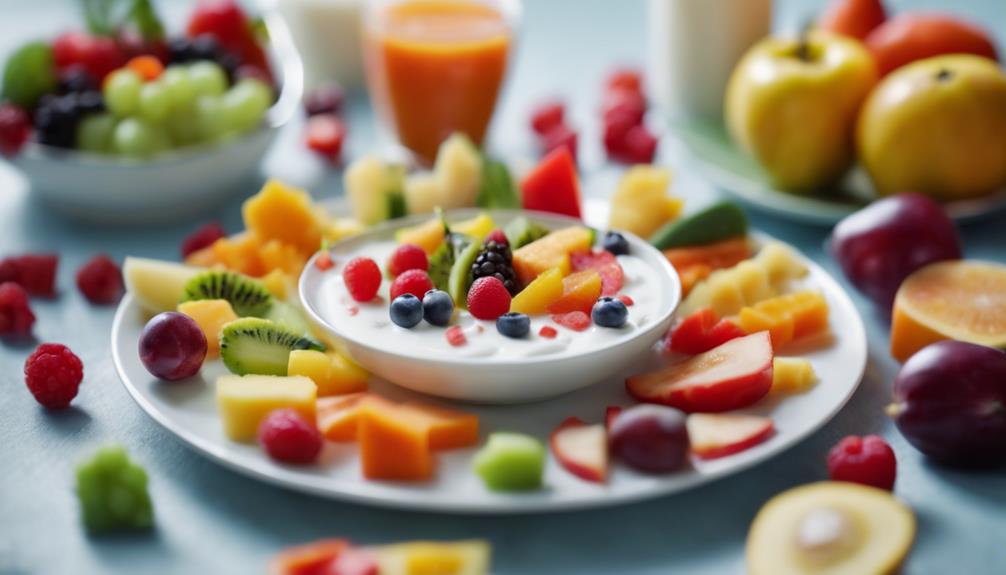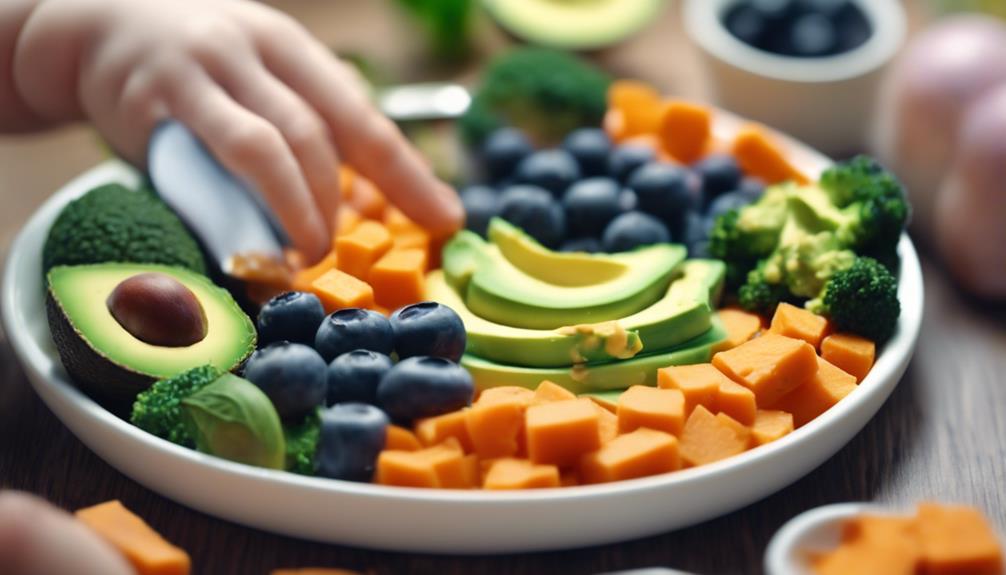When starting solids, it’s important to balance your baby’s milk intake with new foods to support growth and development. Keep milk as the primary nutrition source while gradually offering a variety of tasty solids to introduce textures and flavors. As your baby gets used to eating, you can slowly increase solid portions while maintaining good milk feedings. Staying patient and consistent helps your little one adapt smoothly—if you want to learn more about this balance, there’s helpful guidance ahead.
Key Takeaways
- Continue offering breast milk or formula as the main nutrition source while gradually introducing solids.
- Incorporate new foods alongside regular milk feeds to ensure balanced nutrient intake.
- Increase solid food variety and quantity gradually without reducing milk intake prematurely.
- Monitor your baby’s cues to maintain a healthy balance between solids and milk.
- Remember that solids complement, not replace, milk during initial feeding stages.

Feeding your baby a balanced meal is fundamental for healthy growth and development. As your little one begins to explore solid foods, you’ll want to focus on gradually introducing new textures to help them develop chewing skills and oral coordination. Start with smooth purees, then move on to mashed foods, and eventually to small, soft finger foods. This progression not only makes mealtime more interesting but also helps your baby learn to handle different consistencies, which is critical for their oral development. When introducing new textures, watch for signs of readiness, like sitting upright with minimal support and showing interest in food. It’s also important to be patient, as some babies might need multiple tries before accepting new textures. Keep offering a variety of foods, and don’t get discouraged if your baby initially rejects certain textures. Over time, their palate will expand, and they’ll become more comfortable with different consistencies. Consistent feeding routines can also support your baby’s acceptance of new foods and textures, making mealtime smoother. Managing food allergies is another key aspect when your baby starts eating solids. While most babies tolerate new foods well, some may develop allergic reactions, so it’s essential to introduce new foods one at a time. This approach allows you to identify any potential allergies or sensitivities. When introducing allergenic foods like eggs, nuts, or dairy, do so in small amounts and observe your baby closely over the next 24 to 48 hours for any signs of allergic reactions—such as hives, swelling, vomiting, or difficulty breathing. If you notice any symptoms, contact your pediatrician immediately. It’s also a good idea to discuss your family’s allergy history with your doctor before adding new foods to your baby’s diet. They can provide guidance on which foods to introduce first and how to do so safely. Remember that managing food allergies involves not just careful introduction but also being prepared with emergency measures, like having an epinephrine auto-injector if prescribed. Balancing solids and milk is essential during this stage. Milk, whether breast milk or formula, should still be your baby’s primary source of nutrition, providing essential nutrients and comfort. Solid foods complement milk by offering new flavors and textures, but they shouldn’t replace milk entirely until your baby is older. As your baby gets more comfortable with solids, you’ll gradually increase the amount and variety of foods while maintaining a good milk intake. This balance ensures your baby receives the necessary nutrients for growth, brain development, and immune support. So, be attentive to your baby’s cues, keep mealtimes positive, and stay flexible as they learn to navigate the exciting world of solids while keeping allergies in check.
Frequently Asked Questions
How Do I Introduce Solid Foods Without Causing Allergies?
To prevent allergies during food introduction, you should start foods one at a time and wait a few days before trying something new. This allergy prevention method helps you spot any reactions early. Timing is key; introduce solids around 6 months, but follow your pediatrician’s advice. Keep an eye on your baby’s response, and if you notice any symptoms, consult your doctor promptly.
What Are Signs My Baby Is Ready for Solids?
You’ll know your baby is ready for solids when they show signs like sitting up with minimal support and showing interest in your food. Watch for developmental milestones such as reaching and grasping objects, and be mindful of teething discomfort, which can make chewing tricky. When they consistently open their mouth for food and can swallow, it’s a good sign they’re prepared to start exploring solids.
How Much Solid Food Should My Baby Eat Daily?
You should focus on meal portioning and establishing a flexible feeding schedule for your baby. Start with small amounts, like a few teaspoons, and gradually increase as they get used to solids. Offer solids once or twice a day initially, then add more meals as your baby shows readiness. Watch for hunger cues, and don’t force feeding—let your baby guide the portion sizes and timing.
Can I Give My Baby Cow’S Milk Before Age One?
You shouldn’t give your baby cow’s milk before age one because their digestive system isn’t ready and it can cause iron deficiency. Instead, consider dairy alternatives like formula or breast milk, which provide essential milk nutrition. After your baby turns one, you can gradually introduce cow’s milk, but keep in mind that dairy alternatives are still options if your child has a milk allergy or lactose intolerance.
How Do I Ensure My Baby Gets Enough Nutrients From Solids?
Did you know that by age one, babies should be consuming about 30% of their calories from solids? To guarantee your baby gets enough nutrients, focus on meal planning that includes a variety of foods rich in iron, calcium, and vitamins. Pay attention to nutrient absorption—pair vitamin C-rich foods with iron sources—and offer balanced meals. This approach helps support healthy growth and development as your little one shifts to solid foods.
Conclusion
As you introduce solids and milk, remember that balance is key. Keep offering a variety of foods, but don’t expect perfection overnight. It’s a journey, and sometimes you’ll hit a bump in the road. Trust your instincts and stay flexible — you’re the captain of this ship. With patience and persistence, you’ll find the right mix, turning this phase into a smooth sailing adventure for both of you.










